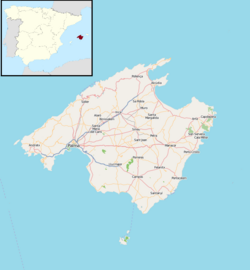Top Qs
Timeline
Chat
Perspective
Sóller
Municipality in Balearic Islands, Spain From Wikipedia, the free encyclopedia
Remove ads
Sóller (Catalan pronunciation: [ˈso.ʎə]) is a town and municipality near the north west coast of the Balearic Island of Mallorca, Spain, 3 km inland from Port de Sóller, in a large, bowl-shaped valley that also includes the village of Fornalutx and the hamlets of Biniaraix and Binibassi. The population is around 14,000. The Tranvía de Sóller tram links Sóller to Port de Sóller.
Remove ads
Overview
Sóller[2] is linked by the historic railway, the Ferrocarril de Sóller, and by a highway with a tunnel, to the Majorcan capital of Palma. The Ferrocaril was built on the profits from the orange and lemon trade and completed in 1911. The Andratx-Pollença highway also runs through the valley. The present-day economy is based mainly on tourism and the expenditure of foreign residents, complementary to the agricultural economy based around citrus and olive groves. Soller is unique compared to towns on the rest of the island due to its geographical isolation, being surrounded by the Serra de Tramuntana. This isolation from all other major towns on the island, made it easier to trade with French merchants arriving by sea.[3]
Remove ads
Main sights
Summarize
Perspective


The focus of the town is the Plaça Constitució which is surrounded by cafés and has plane trees and a fountain in its centre. The tram passes through the Plaça on its way to and from the main station which has been restored to incorporate a museum of Picasso and Joan Miró. The church of Sant Bartomeu (Saint Bartholomew) facing the east side of the Plaça is flanked by the ajuntament (town hall) and the Banco de Sóller, a remarkable 1912 Modernista building with defining ironwork, by the Catalan architect Joan Rubió i Bellver, a follower of Antoni Gaudí. The bank's organisation was founded in 1889 with the money of emigrants who returned prosperous to Sóller. On the other hand, the church can clearly be seen standing out from the canopy of the town from other parts of the Vall de Sóller (the surrounding valley). The original building dates from some time before 1236. The current main interior structure is now largely baroque (1688–1733).
The campanar (belltower) blends in well with its neo-Gothic design. The remarkable façade is a 1904 construction, also by Joan Rubió. The old street plan is of Islamic origin and lined with historic houses of the sixteenth to eighteenth centuries. The town has a covered market and is bisected by a fast flowing river with a number of bridges. Sóller is also notable for the houses built in the early twentieth century by emigrants who returned wealthy to the town, particularly those on the Gran Via which reflect the fin de siècle Art Nouveau styles of France.
The renowned Jardí Botanic (botanical garden) is on the outskirts of the town and is laid out with the plants of the Balearics and the Mediterranean islands. The Modernista mansion in the garden houses El Museu Balear de Ciències Naturals[4] (The Museum of Balearic Natural Sciences).
Remove ads
Events
- "Firó" is Sóller's most important and well-known festival, commemorating its sacking by Moorish pirates on the 11 May 1561. As part of the festivities, 4 battles are reenacted (2 in the Port, 1 in La Huerta and 1 in the town square). Locals dress up as turbaned pirates or in traditional dress and stage mock battles to repel the invaders with fireworks.
- Since 1980, Sóller has hosted the "Sa Mostra" week-long international folklore festival between May and July. It was started by the traditional dance group "Aires Sollerics".[5][6]
- August sees the celebration in honour of the patron saint of Sóller, St. Bartholomew, which features bonfires and devilish masquerades in a spectacle called the "correfoc" ("fire-run"). Local groups such as the "Escladabutzes" invade the town square in an allegory of hellfire, before being driven back by the "correaigua" ("water-run"), where the local fire department refreshes the crowds.
- Each January, Epiphany is celebrated as the Day of the Three Wise Kings, and processions of the Magi proceed from the Port to the town square, throwing sweets to crowds of eager children. Traditionally, it is more popular than the western Christmas on 25 December.
Museums
- Museo de la Mar, a maritime museum. Located in the Oratorio de Santa Caterina d'Alexandria (13th century). (Puerto de Sóller)[7]
- Museu de Sóller: Casal de Cultura (1640), an ethnographic museum and art gallery. Calle de Sa Mar, 13 (Sóller)[8][9][10]
- Can Prunera (a.k.a. Can Magraner) (1911), a modernist townhouse museum. Calle de la Lluna 86 y 90 (Sóller)[11]
- Museo de Ciencias Naturales y Jardín Botánico (1985), the local botanical garden and natural sciences museum. Carretera al Puerto de Sóller[12]
Remove ads
Notable people
- Gregorio Bausá (1590-1656), painter
- Albert Hauf (b. 1938), philologist
- Joan Miquel Oliver (b. 1974), musician
- Tuni (b. 1982), footballer
- Colm Meaney (b. 1953), Irish actor
Gallery
- Torre Picada
- The Banco de Sóller
- Map of the Sóller Tramway
- A tramcar in the Port of Sóller
- The old town of Sóller
See also
References
External links
Wikiwand - on
Seamless Wikipedia browsing. On steroids.
Remove ads











